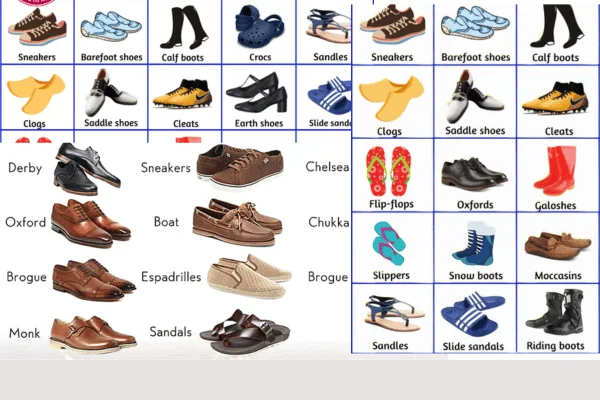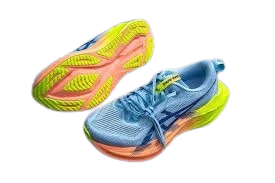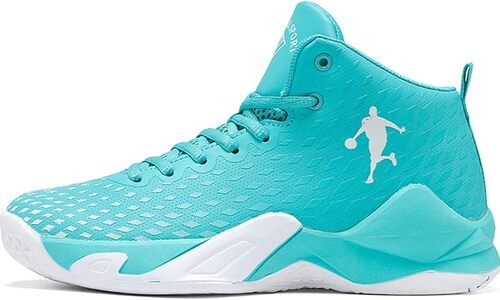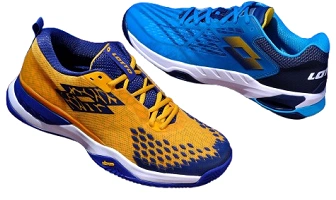Footwear is also known as Shoes, and they serve both the function of living and fashion. They can be used for all activities throughout the day, ranging from just being footsteps to making very important style statements. Shoes come in a different number of styles, primarily designed for special activities, climates, and occasions. This article delves into the different kinds of footwear, the names of each, and their core purposes in detail. This article presents Different Types of Footwear and Their Names.

From protecting our feet with a style statement, the footwear available today is vast and diverse. Various Footwear shoes are made for specific activities, the weather, and occasions: everyone has their name and specialty. For running and jogging, shoes like athletic sneakers are made. Formal events are attended in elegant heels. Boots are specially used for outdoor, into-the-wild adventures. Being familiar with types of footwear helps us make informed choices. The following article describes different types of footwear, their names, and their usages, providing insight into the fascinating world of footwear.
A Comprehensive Guide to Different Types of Footwear and Their Names
Here is the list of Different Types of Footwear with Their Names and features in the following:
1. Athletic Footwear (Sports Shoes)
Designed for physical activities, athletic footwear provides support, cushioning, and stability.

A. Running Shoes
- Lightweight with cushioning for shock absorption.
- Flexible soles for forward motion.
- Examples: Nike Air Max, Adidas Ultraboost.

B. Basketball Shoes
- High-top design for ankle support.
- Thick soles for impact protection.
- Examples: Air Jordan, Under Armour Curry.

C. Soccer Cleats (Football Boots)
- Studs or spikes for traction on grass.
- Lightweight and snug fit for ball control.
- Examples: Adidas Predator, Nike Mercurial.

D. Tennis Shoes
- Flat soles for lateral movement.
- Durable toe guards for court abrasion.
- Examples: ASICS Gel-Resolution, Nike Court Lite.
E. Cross-Trainers
- Versatile for gym workouts, weightlifting, and aerobics.
- Balanced cushioning and stability.
- Examples: Reebok Nano, Nike Metcon.
F. Hiking Boots
- Rugged, waterproof, and ankle-supportive.
- Grippy soles for uneven terrain.
- Examples: Merrell Moab, Salomon Quest.
2. Casual Footwear
Everyday shoes designed for comfort and style.
A. Sneakers (Trainers)
- Comfortable, versatile, and stylish.
- Used for walking, casual outings, and light sports.
- Examples: Converse Chuck Taylor, Vans Old Skool.
B. Loafers
- Slip-on shoes with no laces.
- Often made of leather or suede.
- Examples: Penny Loafers, Gucci Horsebit Loafers.
C. Espadrilles
- Lightweight fabric uppers with rope soles.
- Popular in summer.
- Examples: Toms, Soludos.
D. Boat Shoes (Deck Shoes)
- Non-slip soles, originally for sailing.
- Often made of leather with moc-toe stitching.
- Examples: Sperry Top-Sider.
E. Slip-Ons
- Easy to wear, no fastenings.
- Includes styles like ballet flats and canvas slip-ons.
- Examples: Skechers Go Walk, Sanuk Yoga Slings.
3. Formal Footwear
Elegant shoes suitable for business and special occasions.
A. Oxford Shoes
- Closed lacing system, sleek and formal.
- Common in business and weddings.
- Examples: Allen Edmonds Park Avenue.
B. Derby Shoes
- Open lacing system, slightly less formal than Oxfords.
- More room for wider feet.
- Examples: Clarks Derby.
C. Brogues
- Decorative perforations (wingtips).
- Can be formal or semi-formal.
- Examples: Wingtip Brogues, Longwing Brogues.
D. Monk Straps
- Buckle closure instead of laces.
- Sophisticated and stylish.
- Examples: Double Monk Strap Shoes.
E. Dress Boots
- Formal leather boots, often Chelsea or Chukka styles.
- Worn with suits or dress pants.
- Examples: Chelsea Boots, Chukka Boots.
4. Boots
Sturdy footwear covering the ankle or higher.
A. Ankle Boots
- Stop just above the ankle.
- Includes Chelsea boots and combat boots.
- Examples: Dr. Martens 1460, Timberland Ankle Boots.
B. Knee-High & Over-the-Knee Boots
- Extend to the knee or thigh.
- Fashionable in winter.
- Examples: Stuart Weitzman Over-the-Knee Boots.
C. Work Boots
- Steel-toe or waterproof boots for labor jobs.
- Heavy-duty and durable.
- Examples: Red Wing Iron Ranger, Caterpillar Boots.
D. Cowboy Boots
- Pointed toes, high shafts, and heels.
- Traditional Western wear.
- Examples: Ariat, Lucchese.
E. Snow Boots
- Insulated and waterproof for winter.
- Traction soles to prevent slipping.
- Examples: Sorel Caribou, Columbia Bugaboot.
5. Sandals & Open-Toe Footwear
Breathable shoes for warm weather.
A. Flip-Flops
- Simple rubber thong sandals.
- Casual beachwear.
- Examples: Havaianas, Reef.
B. Slides
- Backless, open-toe slip-ons.
- Popular for lounging.
- Examples: Adidas Adilette, Nike Benassi.
C. Gladiator Sandals
- Strappy design, often lace-up.
- Fashion-forward summer wear.
- Examples: Steve Madden Gladiator Sandals.
D. Clogs
- Wooden or rubber soles, often backless.
- Used in healthcare and gardening.
- Examples: Crocs, Dansko Professional.
6. Specialty Footwear
Designed for unique purposes.
A. Dance Shoes
- Ballet flats, jazz shoes, tap shoes.
- Flexible soles for movement.
B. Orthopedic Shoes
- Designed for foot support and pain relief.
- Examples: Orthofeet, Dr. Comfort.
C. Safety Shoes
- Steel-toe or puncture-resistant for hazardous work.
D. High Heels
- Elevates the heel for fashion.
- Includes stilettos, pumps, and wedges.
- Examples: Christian Louboutin, Jimmy Choo.
Conclusion
This is how we used to see life. This is how someone else saw life. This was all footwear for different people because of the various appearances in the world regarding their tastes and needs. They range from a simple flip-flop to a sophisticated set of loafers or hiking boots, up to delicate ballet flats, and every kind of shoe has come to express virtually everything that someone’s daily chores can do.
Knowing the different types and functions of footwear was necessary not only for choosing the correct pair to wear on any given occasion but also added to the appreciation for the skill involved with every design. The right kind of shoe could very easily determine a person’s daily life, concerning comfort, performance, or style. When you step into your shoes next time, think about the intelligence and innovation that went into the design. Thomas Aiden Lucas.
- You may love to read: Quality Control Workflow in the Footwear Industry
- Moisture Management Guideline for Apparel and Footwear Industry.
- Technical/ QMS/ Quality Audit Checklist of Footwear Industry.
- Footwear Product and Component Safety Requirements.
- Operations of the Material Planning Department in the Footwear Industry.
